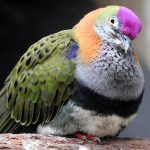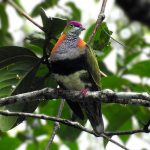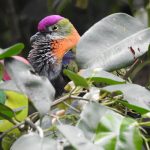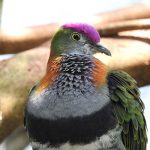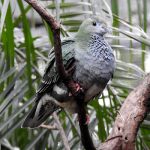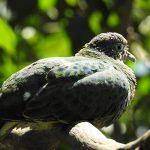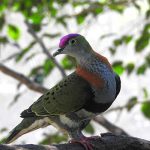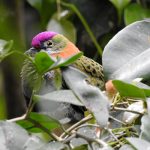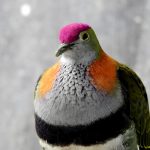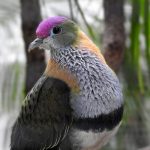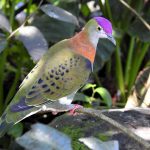SUPERB FRUIT-DOVE
The Superb Fruit Dove
High in the lush, emerald canopies of Australia’s rainforests dwells a bird as colourful as a painter’s palette—the Superb fruit dove (Ptilinopus superbus) This small, exquisitely adorned pigeon is a living jewel of the forest, playing a vital role in the ecosystem and captivating all who catch a glimpse of its vibrant plumage.
Visual and Multi-Sensory Description
Imagine the gentle hush of a rainforest morning, the air cool and laced with the scent of damp earth and flowering trees. Suddenly, a flash of green and purple catches your eye. Perched quietly amidst the dense foliage is the superb fruit dove:
- Size: Small and compact, about the size of a large apple (20-24 cm in length).
- Plumage: The male is spectacular—his head and breast are cloaked in soft, pale grey, crowned with a rich, royal purple patch. His belly glows with orange, and his wings shimmer with emerald green, marked with blue and yellow highlights. The female is equally beautiful, dressed in shades of green that provide perfect camouflage amongst the leaves.
- Sounds: Their call is a soft, rhythmic “coo”, almost like a gentle heartbeat pulsing through the treetops, often heard before the bird is seen.
- Habitat Texture: Perched on a mossy branch, the delicate claws grip firmly, while a faint fruity aroma lingers from the figs and berries they relish.
Habitat and Distribution
| Region | Habitat Type |
|---|---|
| Eastern Australia | Subtropical/tropical rainforests |
| New Guinea | Lowland and hill forests |
| Surrounding Islands | Forest patches and gardens |
Superb fruit doves are found from northern Queensland down to central New South Wales, favouring dense, fruit-rich rainforests, but they may venture into nearby woodlands and cultivated areas in search of food.
Diet and Ecological Role
These birds are frugivores, meaning their diet consists almost entirely of fruit. They are especially fond of:
- Figs
- Palms
- Vines
- Native laurel and myrtle berries
As they travel from tree to tree, eating fruit and dispersing seeds in their droppings, superb fruit doves play a crucial role in the regeneration and health of Australia’s rainforests. Without them, many native trees would struggle to spread and thrive.
Behaviour and Life Cycle
- Elusive Nature: Superb fruit doves are often solitary or in pairs, blending seamlessly into the foliage.
- Nesting: They build delicate, shallow nests from twigs, usually high above the forest floor. The female lays a single, white egg.
- Parenting: Both parents share the duty of incubating the egg and feeding the chick with regurgitated fruit pulp.
Conservation Insights
While currently listed as Least Concern by the IUCN, the superb fruit dove’s habitat is under ongoing threat from:
- Deforestation
- Fragmentation of rainforests
- Reduced availability of native fruiting trees
Conservation of these birds is intimately tied to the preservation and restoration of Australia’s rainforests. By protecting their habitats, we ensure not only the survival of the superb fruit dove, but also the rich biodiversity of the forests they help sustain.
Emotional Connection
The superb fruit dove reminds us that even the smallest creatures can have a profound impact on the world around them. Their quiet presence in the treetops is a testament to the delicate balance of nature. To protect them is to protect the intricate tapestry of life that makes Australia’s wild places so wondrous.
Key Facts Table
| Fact | Detail |
|---|---|
| Scientific Name | Ptilinopus superbus |
| Common Name | Superb Fruit Dove |
| Length | 20–24 cm |
| Habitat | Rainforests, subtropical/tropical woodlands |
| Diet | Fruit (frugivore) |
| Conservation Status | Least Concern (but habitat threatened) |
Final Thought
Through their beauty and their ecological role, superb fruit doves invite us to look closer at the world above and around us, to celebrate and protect not just the rare and mighty, but also the quietly magnificent.

